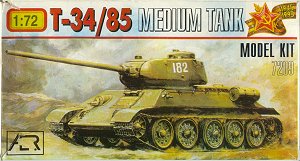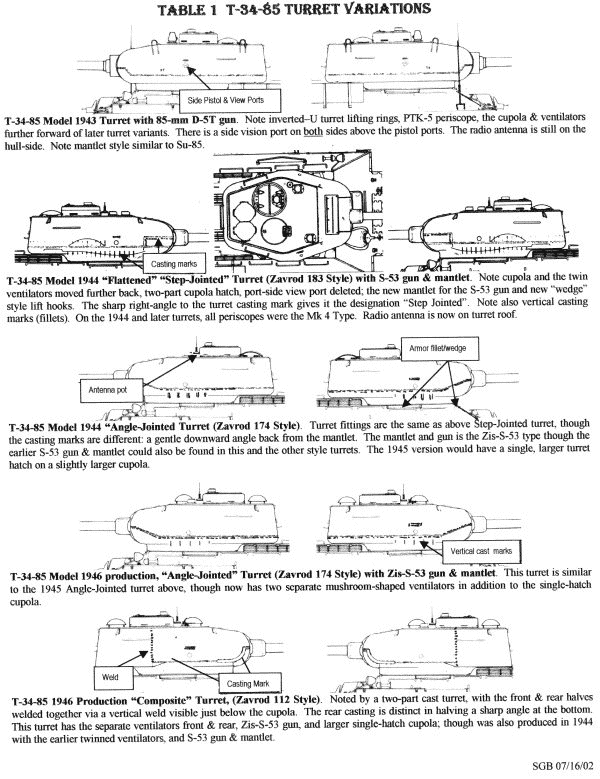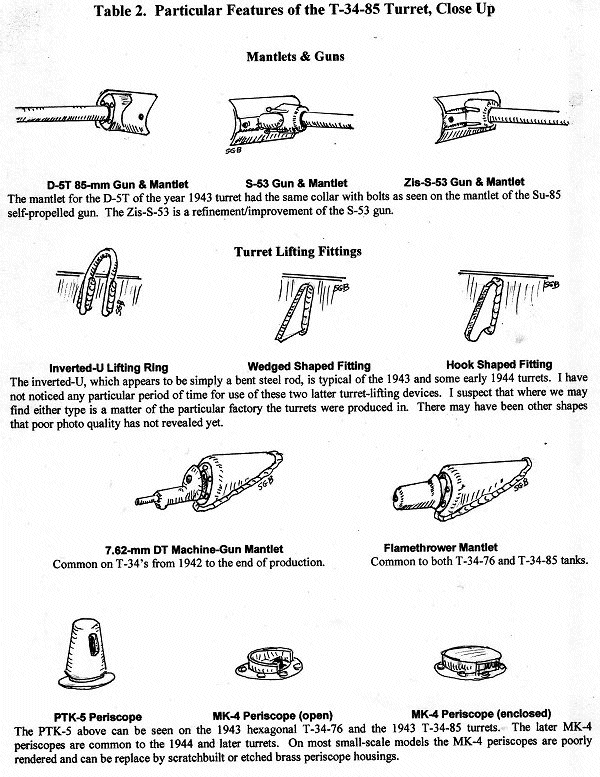
A SHORT GUIDE TO 1/72 T-34-85 TURRETS
IN MODELING...
Turret Identification

A Little History for the Modeler
With the introduction by the Germans of the Panther & Tiger tanks in 1943, the Soviets saw a dire need to upgrade their medium tanks to counter the threat. In March of 1944, the first T-34-85’s with a new turret and 85-mm high velocity gun were released and fortunately, its introduction did not severely upset Soviet tank production, like the Panther did to German panzer production. With the new larger turret, the turret armor was increased to 90-mm in front, 75-mm on the sides, and 52-mm in the rear (Potapov). By the Spring of 1944, over 1200 per month were being produced in the USSR. The T-34-85 proved significantly superior to the Pz IV, and could manage the Panther, which was still superior in AP capability and front armor. T-34 Production continued after WW2 and this tank served in front-line USSR service into the mid-1950’s, until replaced by the T-54 & T-55. Its use continues in small nations around the world today.
According to Hughs & Mann, the designation year "34" was to commemorate the 1934 Soviet state decree for a massive expansion of the USSR’s tank force (and it was also the year that the developer had this new-tank proposal accepted). Andrey Cheremisken corrects this in stating that Soviet publications explain the designation "T-34" is derived from the use of the letter "A" by the Kharkov Locomotive Factory #183 for experimental tanks, such as A-20 and A-32 and then A-34. Nothing to do with the year. With the mass production of the A-34 the "A" designation was changed to "T" resulting in T-34. As other factories picked up production, each plant accommodated the tank to its own capabilities and technology. Therefore a T-34 from Krasnoye Sormova plant #112 on the Volga River differed in many details from a T-34 produced at plant #183 at Nizshniy Tagil in the Urals (formerly the plant in Kharkov before being relocated in 1941).
According to Potapov, total production was 300 T-34-85’s armed with the D-5T gun, while M. Barjatinskiy estimated about 255 T-34’s with the D-5T gun made, including two early turrets with only one roof ventilator. About 107 D-5T’s went to KV-85’s and 100 to 130 to IS-85’s and experimental AFV’s. From 1944 & 1945: 11,518 S-53 guns, and 14,265 Zis-S-53 guns were produced all of which went to the T-34-85, except for some going to the T-44. The Zis-S-53 is an improved S-53 gun produced by Plant #92 in Gorky. (By the way, Zis stands for Zavod imeni Stalina.)
Production started at Plant #112 in January-February 1943, at Plant 183 in March 1944, and at Plant #174 in Omsk in June 1944. About 1200 T-34-85’s per month were being produced in the spring of 1944. This production was larger than the total war production of Tiger II’s, so perhaps "Quantity does have a quality of its own" (Stalin)! Its production continued after the war, in the USSR, Poland, and Czechoslovakia. Yugoslavia produced a small number of a very unique variant with a radically different turret and modified glacis plate.
A small number of T-34-85’s were captured and put into use by Germany, Finland and Rumania. Some of these captured tanks were repainted with new camouflage and markings, while many were just expediently put back in service until they broke down or were destroyed. Several captured T-34-85 tanks are still on display at Finland’s Parola Museum.
An article by a Soviet writer I read also corrects us in that the proper designation is T-34-85, not T-34/85 (despite how it is labeled on AER’s box?!). The term T-34-76 was not used until the 85-mm weapon was developed.
Turret Features
As I have said above, in my opinion, T-34 variants appear to be set apart from each other primarily by their turrets. In the hull there are some changes to the rear engine hatches, welded joints, front fenders, fuel tanks and smoke canisters, but it seems to be the turrets that set variants apart from one model year to another. Keep in mind also, that damaged vehicles were often re-built and upgraded in the process, so it was possible to find, for example, a 1944 chassis with a 1945 production turret. Below I will be using terms like angle-jointed turrets, composite or laminated turrets, and fillets. Take note that these are not official terms used by the Soviets during production but are used by historians and modelers to help tell them apart. I believe the Soviets used factory numbers: Zavod #174 style, or Zavod #112 style for example (Zaloga).
Thick positive lines on the turret surfaces have been mistakenly referred to as "welds" before. In most cases these are casting seams not welds. Different castings were the result of different capabilities, production methods and refinements at the various factories. Without going into extensive detail, I understand that tank turret and hull castings are done using a sand mold inside and out. During the casting process the sand may shift and be uneven, causing the rough texture seen on T-34-85’s. The joints where the mold parts come together when assembled cause the casting lines (something like flash on a plastic model). Some manufacturers around the world grind this excess metal away to give a smoother appearance, but in WW2, the USSR did not have time or money for this luxury. Casting can be quicker than cutting and welding rolled-armor plate, though when improperly done can lead to bubbles or voids in the armor or uneven thickness. An exception to this welding issue is with the "Composite" type turret construction. This turret consisted of two separate cast parts with a vertical weld joining the two parts together. This composite type can be seen in 1944, 1945 and 1946 variants (see Table 1 below). It is most obvious by the sharp edge of the rear bottom. The Composite turret is also known as the "Laminated" turret.
The Commander’s cupola top rotates, so while it is usually seen with the hatch opening forward, this is why the hatch(es) can also be seen opening off to the sides.
A Little More About Turret Types
The turret types, or names, which I use are borrowed from other publications in my resources listed at the end of Part 2. Besides casting types, I break the turrets into years based on particular features. Turrets labeled "1943" all are common in having the D-5T gun and mantlet, radio antenna still in the hull, two-person turret, cupola and vents more towards the center of the turret roof, view slits and pistol ports on both sides of the turret, and inverted U-shaped lift rings. The 1943-year model appears only to have been produced with a type of angle-jointed casting. 1944 Turrets are common in having the S-53 gun & mantlet, twin roof vents and spit-hatch cupola now moved further to the rear, triangular lift hooks, and only one view slit on the turret's starboard side. 1945 Turrets are similar to the 1944-year turrets but have the Zis-S-53 gun and mantlet, and a larger cupola with a single hatch. Year 1946 turrets are similar to the 1945 turrets but have two separate roof vents. One of the vents being moved forward of the cupola for better ventilation of gun fumes.
Table 1 below outlines the major turret variations during and after the war and when you first might see them. The table is meant to be representative and not all inclusive of all variations in casting marks and features. This may seem a bit anal-retentive to some modelers, but for builders who are into tight historical accuracy, or for national contests, this can make or break a diorama. For example, my first T-34-85 was a Model 1943 depicted in Korea 1950, which is highly unlikely. A 1945 production modeled at Kursk is just as historically incorrect.

Not all of these casting marks are readily visible in historical photographs due to the variations in the casting, photo quality, lighting, or distance. They may be easily confused. Many Step-Jointed turrets appear to have no vertical fillets. Some Step-Jointed turrets have two parallel horizontal casting lines running the perimeter of the turret. I have not seen any Composite turrets with vertical fillets.
Table 2 below shows a number of turret fittings or features and when you might have seen them. One important thing to consider in all of this is that fittings were likely phased in, and rebuilds and repairs can mate items that where not true to the particular variant year. An example is the 1944 turret with S-53 gun but with the inverted-U shaped lifting rings of the 1943 turret. This could be the result of a phased-in series of changes, or perhaps a rebuild of a battle damaged turret?

The next part of this article covers a review of actual kits and accessories. This article is intended to be dynamic and will be updated as new items are released or discovered. As it is really a skim of information on the T-34, I encourage those interested to also check out the resources I have listed at the end of of the article.
Turret Identification
| Back to Articles Page | Back to Home Page |